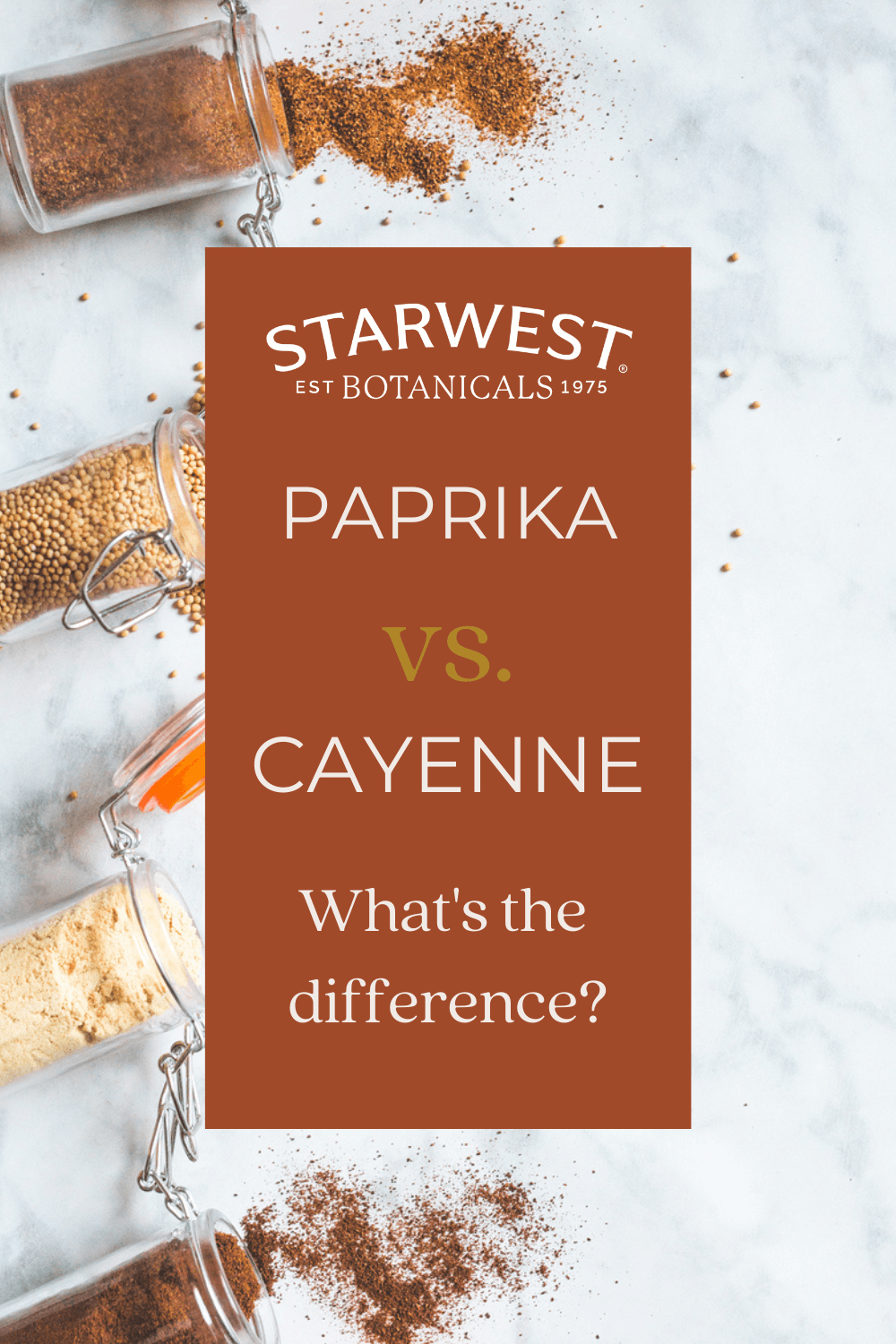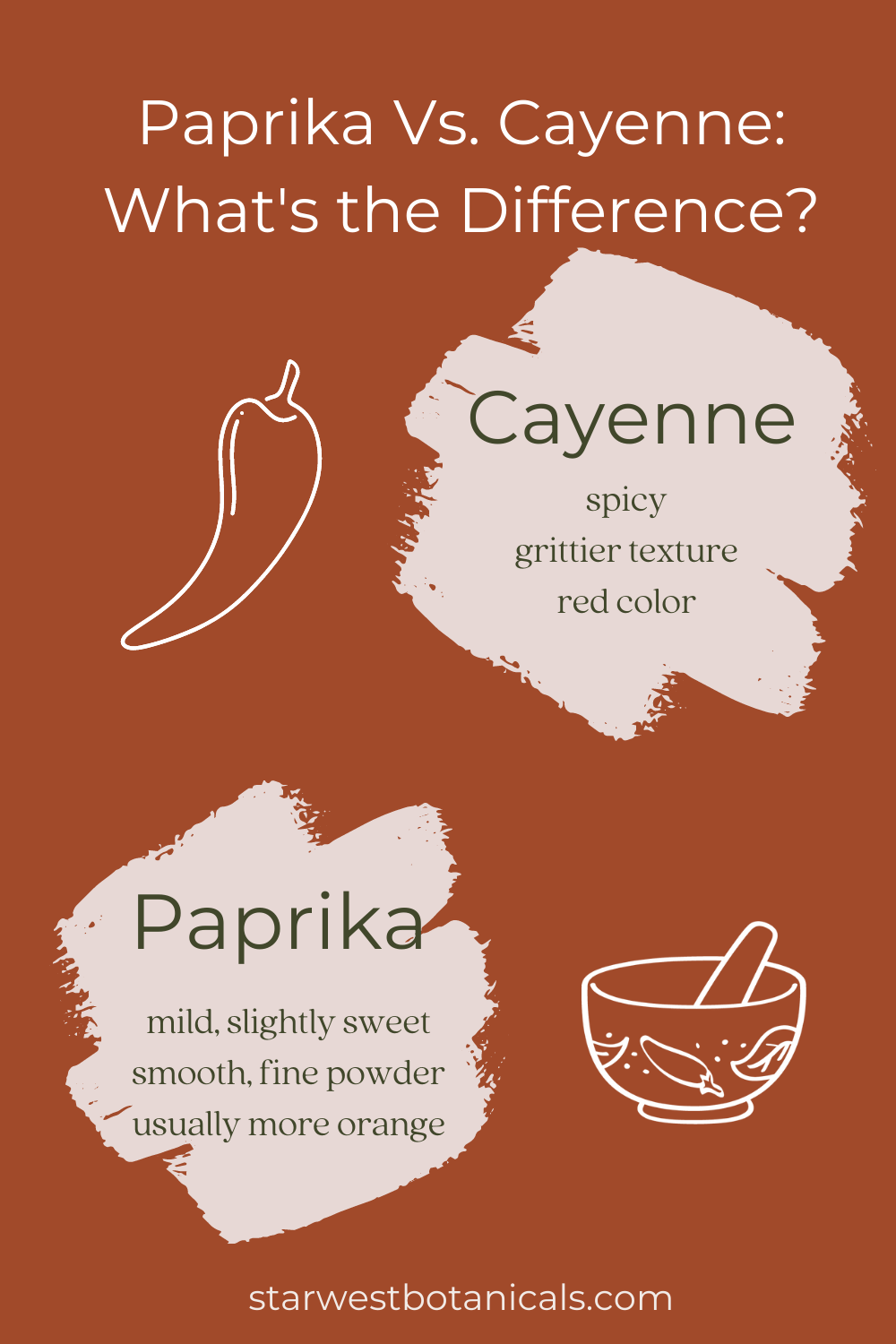Paprika vs Cayenne: What's the Difference | Starwest Botanicals
Posted by Starwest Botanicals Content Team | Medically Reviewed by Daniel Powers, MS on 07-12-2022

Whether you’re prepping a pot of chili or tossing together some tofu tacos, spices make all the difference. With that said, most spices are different from each other, too. Cayenne and paprika are no exception.
Because they’re occasionally found in recipes together, you may assume that paprika and cayenne are somewhat interchangeable since they both look like ground red pepper. Both come from dried peppers, have a deep red color, and feature a slightly smoky flavor. However, that’s where the similarities end.
So, when you’re craving more of that smoky, earthy flavor, should you reach for paprika or cayenne? Whether you're looking to buy bulk seasoning or just a couple jars, a better question might be: Do you even need both of these spices in your pantry? In this quick comparison of paprika vs cayenne, we’ll look at where they came from, when to use them, and why they both belong in your spice rack.
Origins
Because paprika and cayenne come from peppers, both can technically trace their roots back to the Americas. However, the two spices don’t come from the same kind of pepper—nor are they prepared the same way.
Where Does Paprika Come From?
Paprika is made by grinding dried red peppers from the Capsicum annuum family. These peppers can be sweet (like bell pepper) or spicy (like chili pepper). Different varieties of paprika use different types of peppers, as well as various parts of the plant.
The three main types of paprika are:
- Regular Paprika – Also known as sweet paprika, your regular paprika is a relatively mild spice with a hint of sweetness and heat. Because it only includes the flesh of the pepper, paprika has little (if any) heat.
- Smoked Paprika – The smoky flavor of smoked paprika comes from the drying process. Depending on the type of wood burned to dry the peppers, the taste can vary.
- Hot Paprika – Usually associated with Spanish cuisine (where it’s called pimentón), hot paprika includes the seeds and other parts of the pepper plant, leading to a spicier product. You can also find hot smoked paprika—a spicy blend with a hint of smoky flavor.
Where Does Cayenne Come From?
Cayenne comes from the cayenne pepper. These peppers are also part of the Capsicum annuum family, but they’re much hotter than the peppers used to make paprika (from 35,000 Scoville heat units and up).
As with paprika powder, ground cayenne pepper powder is made from ground dried peppers. These rich red peppers give the spice its vibrant color.
Nutritional Values and Benefits
Like many spices, cayenne and paprika may offer a range of health benefits. Both are loaded with nutrients and may have other healing qualities, too. And if you are wondering, is it worth buying organic spices— in order to have the highest quality and healthiest spices, it just might be.
Is Paprika Good for You?
Not only is paprika delicious, but it’s also nutritious. Along with moderate amounts of vitamin A, E, and B6, one tablespoon of paprika contains (among other things):
- 15.66 mg of calcium
- 1.44 mg of iron
- 12.1 mg of magnesium
- 155 mg of potassium
What’s more, paprika contains antioxidants and may contribute to:
- Improved vision and eye health
- Blood health and blood sugar control
Is Cayenne Good for You?
If you can handle the heat, it may be worth sprinkling cayenne powder on every snack and meal. Cayenne contains a moderate helping of several vitamins, including:
- Vitamin A
- Vitamin B6
- Vitamin C
- Vitamin K
Additionally, some evidence suggests that cayenne may:
- Promote healthy digestion
- Help with weight care
- Reduce inflammation

Paprika vs Cayenne: Differences in the Kitchen
While paprika and cayenne have their own stories and benefits, the real differences lie in their culinary uses. In the kitchen, the difference between cayenne and paprika shows up in three ways:
- Flavor – Cayenne is a fiery spice that adds heat to any dish, while paprika has a milder, slightly sweet taste.
- Consistency – Cayenne has a grittier texture; paprika is ground into a smooth, fine powder.
- Color – Cayenne powder is usually more orange in color, whereas paprika has a deeper, richer red to it.
So, can you substitute cayenne for paprika (or vice versa)? While you’ll at least end up with a similarly colored dish, the flavor won’t be the same. In a pinch, you could throw in a dash of hot paprika in place of cayenne powder. However, we wouldn’t suggest substituting these spices the other way around—you could wind up with a way-too-spicy sauce!
Where Does Chili Powder Fit In?
Many aspiring chefs take the question about cayenne and paprika one step further by asking about paprika vs chili powder vs cayenne.
The main difference between chili powder and the two spices we’ve covered is that chili powder actually comes from a blend of red pepper flakes. It’s also much hotter than cayenne powder—ours comes in at a whopping 160,000 Scovilles.
Paprika or Cayenne: Which One is Better?
Taste is subjective, so we can’t make this decision for you. You’ll have to try them both for yourself and find out which one you like best!
Whether you prefer the mild, smoky taste of paprika or the fiery kick of cayenne, one thing’s for sure: Food tastes better when it’s packed with high-quality spices.
If you’ve never tried paprika and cayenne pepper side by side, it’s time for a taste test. When you order bulk spices from Starwest Botanicals, you can sample in confidence, knowing that your spices are all-natural and bursting with fresh flavor.
Sources:
NPR. Chili Say What? Linguistics Help Pinpoint Pepper's Origins. https://www.npr.org/sections/thesalt/2014/04/17/304139132/chili-say-what-linguistics-help-pinpoint-peppers-origins
Encyclopedia Britannica. Paprika. https://www.britannica.com/topic/paprika
U.S. Department of Agriculture. FoodData Search Results: Spices, paprika. https://fdc.nal.usda.gov/fdc-app.html#/food-details/171329/nutrients


